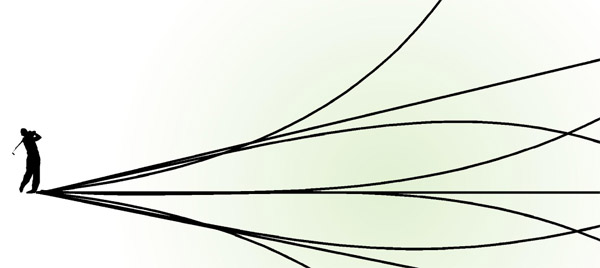Does “Working The Ball” Matter?
“Working the ball” is simply a matter of controlling the face angle and path of the clubhead coming into impact.
History
One of my favorite modern day subjects is, “working the ball.” Most of us have heard that better players prefer the old fashioned blade type irons because they can more easily work the ball and they also get much better feedback when they mis-hit a shot.
This is a perpetuated myth kept alive by unknowledgeable players, magazine writers, TV tournament personalities and the manufacturers in their ads to only name a few.
Should I Be “Working The Ball”
There are currently hundreds of players using higher MPF irons on all the professional tours. Do you think for one minute any one of these players would be playing an iron set that prevented them from hitting high and low shots and draws and fades at will?
Over the years, I have had this discussion many times with the touring pros and better players I have worked with who play older technology irons. Their first reaction to higher MPF irons is they look so much longer.
I tell them to hit them for one week and play practice rounds with them. By the end of the week they are usually settled in with the new look and always tell me that now their old irons look short and stubby and the new irons now look normal.
They also stick with the new irons because they realize immediately that they are actually hitting the ball better. Working the ball has never been an issue with touring pros after they switch to higher playability irons.
If only everyone understood that working the ball right to left or left to right was simply a matter of controlling the face angle and path of the clubhead coming into impact, we would once and for all kill this myth.
Why The Myth Still Exists
Here is another “Catch-22” point to make on so-called draw bias irons. The golfer that is attracted to this older technology is usually a slicer and thus not a very good player with poorer ball striking ability. The draw bias irons are going to have a horizontal center of gravity more located toward the hosel, which is not going to be in the geometric middle of the face.
The golfer does not know this and like most golfers will always attempt to hit the ball in the middle of the face. This caliber of player does not have the ability to consistently find the actual center of gravity location or the iron’s sweet spot.
The better golfer or tour player has the ability to automatically migrate to this hitting spot because it will always feel the most solid to them. So, the unwary golfer starts out by setting up and attempting to hit the ball on the center of the face.
We all know that to hit the ball solid the impact location needs to be as close to the horizontal center of gravity (sweet spot) as possible. The less skilled golfer is attempting to hit the ball in the geometric face center, but his draw biased irons have the center of gravity in the heel area and he wonders why the shots are not solid and he loses distance.
Assume now that the new draw bias iron also happens to have a relatively high vertical center of gravity and an MPF below Game Improvement. This type design could keep a golfer wondering, “Is it me or is it my equipment?”
